Search Engine Land’s Periodic Table Of SEO Ranking Factors is designed to illustrate the most important things that can help you gain traffic from search engines such as Google and Bing. This is our companion guide designed to explain the table in more depth and provide a tutorial into the world of search engine optimization.
Search Engine Ranking Factors
There are four major groups of SEO ranking factors:
- On The Page Ranking Factors
- Off The Page Ranking Factors
- Violations
- Blocking
Within each group are are subgroups, as further pages of this guide will explain. Each of those subgroups contain one or more individual SEO factors.
Those two letter acronyms you see on the chart? That’s our play on the periodic table of elements, and its two letter representations of each element. The first letter of each “SEO element” comes from the subgroup that it’s in. The second letter stands for the individual factor.
Factors Work In Combination
No single SEO factor will guarantee search engine rankings. Having a great HTML title won’t help if a page has low quality content. Having many links won’t help if they are low quality links. But having several positive factors can increase the odds of success. As for negative factors, they obviously can worsen the odds.
On The Page Factors
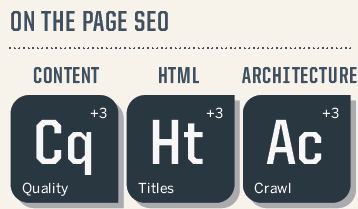 On The Page search ranking factors are those that are entirely within the publisher’s own control. What type of content do you publish? Are you providing important HTML clues that help search engines with determining relevancy? How does your site architecture help or hinder search engines?
On The Page search ranking factors are those that are entirely within the publisher’s own control. What type of content do you publish? Are you providing important HTML clues that help search engines with determining relevancy? How does your site architecture help or hinder search engines?
Off The Page Factors
 Off The Page ranking factors are those that publishers cannot directly control. Search engines use these because they learned long ago publisher signals alone don’t help relevancy. Some publishers will try to make themselves seem more relevant than they are, for example.
Off The Page ranking factors are those that publishers cannot directly control. Search engines use these because they learned long ago publisher signals alone don’t help relevancy. Some publishers will try to make themselves seem more relevant than they are, for example.
More important, with billions of web pages to sort through, looking only at on-the-page clues isn’t enough. More signals are needed to better estimate what are the best pages for any particular search.
Violations
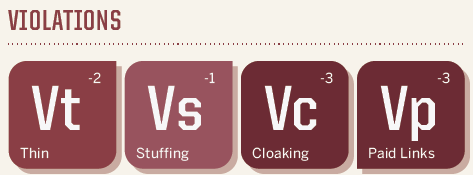 Make no mistake. Search engines want people to perform SEO. They provide help directly about SEO techniques and encourage this, because good SEO can improve their listings.
Make no mistake. Search engines want people to perform SEO. They provide help directly about SEO techniques and encourage this, because good SEO can improve their listings.
However, there are some techniques that they deem “spam” or “black hat,” acts that if you do could results in your pages getting a ranking penalty or worse, being banned from the search engines entirely.
Blocking
 Blocking is a new class of ranking signal. This is where searchers themselves may decide they don’t like pages from a particular web site, even if those web sites don’t violate any traditional spam rules.
Blocking is a new class of ranking signal. This is where searchers themselves may decide they don’t like pages from a particular web site, even if those web sites don’t violate any traditional spam rules.
Blocking has a big impact on what the individual who blocks sees, but it also has an impact on what every searcher sees.
Weighting
All the factors we show are weighted on a scale of one to three, as shown in the top right corner of each factor. Three is deemed most important, something that you either should especially pay attention to, because it has a bigger impact than other factors.
That doesn’t mean that factors weighted only two or one aren’t important. They are, or they wouldn’t have made the chart. It’s just that they are off less importance in relatively speaking, in terms of everything on the chart.
The weighting is also our opinion, based on what search engines have said, surveys done of SEO and our own experience in watching the space over time. They’re not perfect; not everyone will agree with them. But we think they’re a useful general guide.
Violations and Blocking factors are also weighted in negative numbers, with negative three being the worst.
“Missing” Factors & The Guide’s Philosophy
Some experienced SEOs may be wondering why some factors aren’t shown. How come ALT text or bolding words aren’t included as important HTML factors, for example?
The answer is that we don’t think those things are that important, relatively speaking. We’re not trying to encompass every possible signal (Google has over 200 of them) and sub-signals (Google has over 10,000 of those).
Instead, the goal with the Periodic Table Of SEO Ranking Factors and this online companion guide help those new to SEO focus on the big picture and perhaps help some experienced SEO hit the “reset” button if they’re feeling a bit lost among the trees of the SEO forest.
That’s why this guide doesn’t try to get into the debate over whether having your most important keywords be at the beginning or end of an HTML title tag. Nor are we trying to assess if H1 header tags carry more weight than H2 tags.
We’re purposely avoiding being so specific because such things can easily become overkill. Instead, we want you to understand that your pages should have descriptive titles, that indicating page structure with header tags may help, and topping things off with easily deployed meta description tag is a good idea Do these things, and you’d probably addressed 90% of the most important HTML-related factors.
Similarly, it’s not whether a good reputation on Twitter is worth more than on Facebook. Instead, it’s trying to help people understand that having social accounts that seem reputable in general, which attract a good following and generate social shares, is a good that may help you with your search efforts.
But I Want More!
Having said that, some may want to drill down into specifics, to the degree anyone can agree on this. In that case, the SEOmoz Search Engine Ranking Factors survey is worth looking at. Every two years, it tries to harness the collective knowledge of what hundreds of SEOs think are important and specific ranking factors.
You might also look at the Covario’s SEO Audit Score whitepaper, which can be downloaded here, though you have to go through free registration to get it. It analyzes some specific factors from nearly 1 million pages to try and determine what’s most important.
Over time, we’ll add other links to detailed surveys like this. But we do hope you’ll keep any specifics in the context of the fundamentals our table covers. Also see our What Is SEO / Search Engine Optimization? page, which lists some useful guides to the fundamentals (including one from Google itself) along with many more SEO resources.
Of course, the guide you’re reading now is also a great resource for understanding the key SEO factors anyone should know. Use the “Next” link below to continue reading forward through the guide. The “Everything” links will let you easily jump between sections.
Content & Search Engine Ranking Factors
You’ll hear it over and over again. Content is king, when it comes to aiming for success with search engines. Indeed, that’s why the Periodic Table Of SEO Ranking Factors begins with the content “elements,” with the very first element being about content quality. Get your content right, and you’ve created a solid foundation to support all your other SEO efforts.
 Cq: Content Quality
Cq: Content Quality
More than anything else, are you producing quality content? If you’re selling something, do you go beyond being only a brochure with the same information that can be found on hundreds of other sites?
Do you provide a reason for people to spend more than a few seconds reading your pages?
Do you offer real value, something of substance to visitors, anything unique, different, useful and that they won’t find elsewhere?
These are just some of the questions to ask yourself in assessing whether you’re providing quality content. Do provide it, because it is literally the cornerstone upon which other factors depend.
Below, some articles on the topic of content quality from Search Engine Land, to get you thinking in the right direction
- Living Content: It’s What People Want
- User Generated Content Offers Significant SEO Benefits
- 6 Content Tips: How To Write When You Have Nothing To Write About
- Why Quality Is The Only Sustainable SEO Strategy
- From Garbage To Gourmet: Fixing SEO Content Strategies
- Impacted By Google’s Panda Update? Google Asks You To Consider This…
Cr: Content Research / Keyword Research
 Perhaps the most important SEO tactic after creating good content is good keyword research. There are a variety of tools that allow you to easily, and for free, discover the ways that people may be searching for your content.
Perhaps the most important SEO tactic after creating good content is good keyword research. There are a variety of tools that allow you to easily, and for free, discover the ways that people may be searching for your content.
You want to create content using those keywords, the search terms people are using. That effectively lets your content “answer” them.
For example, a page about “Avoiding Melanoma” may be using technical jargon to describe ways to prevent the most dangerous type of skin cancer. If people are searching for “skin cancer prevention tips,” then writing in the wrong “language” might cause search engines to skip your content as a possible answer.
Create content that speaks to what people are searching for, that uses the language that they themselves are using. Our guide below points you to a variety of tools that will help:
Here are some articles from Search Engine Land that explore the topic of keyword research in more depth:
- The Giant List Of Keyword Tools
- You Say Law Firm, I Say Lawyer
- Of SEO And Spaghetti Sauce
- Priceless Keyword Research Data You Already Have – But Never Use
- How Mobile Searchers Are Changing Keyword Research
- Using Social Awareness Streams To Learn What People Care About
 Cw: Content Words / Use Of Keywords
Cw: Content Words / Use Of Keywords
Having done your keyword research (you did that, right?), have you actually used those words in your content? Or if you’ve already created some quality content before doing research, perhaps it’s time to revisit that material and do some editing.
Bottom line: if you want your pages to be found for particular words, it’s a good idea to actually use those words in your copy.
How often? Repeat each word you want to be found for at least five times or seek out a keyword density of 2.45%, for best results.
OK, that was a joke. There’s no precise number of times, and even if “keyword density” sounds scientific, honest, even if you hit some promised “ideal” percentage, that would guarantee nothing.
Just use common sense. Think about the words you want a page to be found for, the words you especially feel are relevant from your keyword research. Then use them naturally on the page. If you commonly shift to pronouns on a second and further references, maybe use the actual noun again here and there, rather than a pronoun.
For more advice, see some of our articles below:
- Ten Copywriting Tips for SEO
- Useless SEO Terms: Linkbait & SEO Copywriting
- Simple Tips For Writing An SEO Style Guide
- Better SEO Through Jargon
- Google Provides “Reading Level” Filter & Statistics
 Ce: Content Engagement
Ce: Content Engagement
If you’ve written quality content, then users will be engaging with it. To determine that, search engines may try to measure engagement in a variety of ways.
For example, did someone search, find your page in the listings, clickthrough but then immediately “bounce” back to the results to try something else? That can be a sign that your content isn’t engaging. It’s also a metric search engines can measure.
Are people sending a relatively long time reviewing your content, in relation to similar content on other sites? That “time on site” metric is another thing that search engines can measure, such as through toolbars that both Google and Bing offer.
Social “likes” of the Facebook type and other varieties are another way that engagement might be measured, and we’ll cover these more in the Social section of this guide.
Search engines are typically cagey about if they use engagement metrics much, much less exactly what metrics they may use. But we do think it is a factor being measured in several ways. Success here is highly linked to the quality of your content.
Below, articles from us on the importance of engagement:
- B2B Engagement Matters: Seven Ways to Keep ‘Em Coming Back for More
- The Farmer/Panda Update: New Information From Google
- Your Site’s Traffic Has Plummeted Since Google’s Farmer/Panda Update. Now What?
Cf: Content Freshness
 No, you can’t just update your pages every day thinking that will make them “fresh” and thus more likely to rank better with search engines. Nor can you just add new pages on anything constantly and think that gives you a freshness boost, either.
No, you can’t just update your pages every day thinking that will make them “fresh” and thus more likely to rank better with search engines. Nor can you just add new pages on anything constantly and think that gives you a freshness boost, either.
However, Google does have something it calls “Query Deserved Freshness.” This means that if there’s a search that’s suddenly getting unusually popular versus its normal activity for some reason, Google will look to see if there’s any fresh content on that topic and give it a boost toward the top results.
If you’ve got the right content, on the right topic when QDF hits, you may enjoy being in the top results for a week or two or three. Just be aware that after that, your page might disappear. It’s not that you’ve done anything wrong. It’s just that the freshness boost has worn off.
HTML Code & Search Engine Ranking Factors
HTML is the underlying code used to create web pages. Search engines can pick up ranking signals from specific HTML elements. Below, some of the most important HTML tags you should pay attention to.
 Ht: HTML Title Tag
Ht: HTML Title Tag
Imagine that you wrote 100 different books but gave them all the same exact title. How would anyone understand that they are all about different topics?
Imagine that you wrote 100 different books, and while they did have different titles, they weren’t very descriptive — maybe just a single word or two. Again, how would anyone know at a glance what the books are about.
HTML titles have always been and remain the most important HTML signal that search engines use to understand what a page is about. Bad titles on your pages are like having bad book titles in the examples above.
Think about what you hope each page will be found for, especially relying on your keyword research. Then craft unique, descriptive titles for each of your pages. For more help about this, see our tutorial below:
 Hd: The Meta Description Tag
Hd: The Meta Description Tag
One of the oldest supported HTML elements, the meta description tag allows you to suggest how you’d like your pages to be described in search listings.
SEO purists will argue that the meta description tag isn’t a “ranking factor,” in that it doesn’t actually help your pages get a boost to the top. Rather, it’s a “display factor,” something that helps how you look if you appear in the top results because of other factors.
Technically, that’s correct. Yet, as search engines are looking at things like engagement, whether your listing even attracts a click is a ranking factor. A good description can increase the odds of that click. So we feel the meta description tag should be counted as a ranking factor.
Having a meta description tag doesn’t guarantee that your description will actually get used. Search engines may create different descriptions based on what they decide is most relevant for the particular query that a listing is shown for. But it increases the odds that what you prefer will appear. It’s easy to do. So do it.
Below, Search Engine Land articles that take a closer look at the meta description tag:
- Google’s Tips On How To Write A Good Meta Description
- Meta Tag Optimization Tips: A Search Usability Perspective
- The Anatomy Of A Google Search Result
 Hh: Header Tags
Hh: Header Tags
See the headline up at the top of this page? Behind the scenes, HTML code is used to make that a header tag, an H1 tag in particular.
See the sub-headlines on the page? Those also use header tags. Each of them is the next “level” down, using H2 tags.
Header tags are a formal way to identify key sections of a web page. Search engines have long used them as clues to what a page is about. If the words you want to be found for are in header tags, you might have a slightly increased chance of appearing in searches for those words.
Naturally, talk of header tag “boosts” has caused some people to go overboard. They’ll put entire paragraphs in header tags. That doesn’t help.
Header tags are useful when they reflect some logical structure to a page. If you have a main headline, using an H1 tag makes sense. Subheads in H2 make sense. Use headers as they make sense, and they may reinforce some of your other ranking factors. Don’t use them, and that’s OK. They’re a minor factor, anyway.
Site Architecture & Search Engine Ranking Factors
The last major “On The Page” group in the Periodic Table Of SEO Ranking Factors is that of your overall site architecture. The right site structure can help with your SEO efforts. The wrong one can cripple them.
 Ac: Site Crawability
Ac: Site Crawability
Search engines “crawl” web sites, going from one page to another incredibly quickly, acting like hyperactive text scanners. They make copies of your pages, which get stored in what’s called an “index,” which is like a big book of the web.
When someone searches, the search engine flips through this big book that it has created, finds all the relevant pages and then picks out what it thinks are the very best ones to show first.
To found, you have to be in the book. To be in the book, you have to be crawlable. Most sites generally don’t have crawling issues, but there are things that can cause problems.
For example, JavaScript or Flash potentially can hide links, making the pages those links lead to hidden from search engines. Related to this, both can potentially cause the actual words on pages to be hidden.
Most problems can be easily avoided. In addition, a good practice is to make use of sitemaps, both the HTML and XML variety. You’ll find more about sitemaps and dealing with potential crawling issues in the Search Engine Land articles below:
- SEO Vs. Web Site Architecture
- The “Design” Part Of Search Engine Friendly Design
- Site Navigation & Information Architecture Fundamentals For SEOs
- How To Avoid Clunky Web Design With Holistic SEO & Usability
- Google Now Crawling And Indexing Flash Content
- Site Navigation & Information Architecture Fundamentals For SEOs
- How To Make Flash Content Search Friendly
- Google May Be Crawling AJAX Now – How To Best Take Advantage Of It
- Canonical Tag 2.0: Google To Add Cross Domain Support
- Google Writes Google Sitemaps FAQs
- Google XML Sitemaps Now Supports Multiple Types: Is the Sitemaps Alliance Over?
Remember, “search engine friendly design” is also “human friendly design!”
 As: Site Speed
As: Site Speed
Google wants to make the web a faster place, so much so that it has declared that speedy sites get ranking advantage over slower sites.
Boosting your web site’s speed isn’t a guaranteed express ride to the top of Google’s results, however. It’s a minor factor, but one that can help reinforce others.
So speed up your site, if you can. Your human visitors will probably appreciate it, too!
Below, some of our past coverage of the importance of site speed:
- It’s Official: Google Now Counts Site Speed As A Ranking Factor
- Google Releases Page Speed Report In Webmaster Tools
- Google’s Push To Speed Up Your Web Site
- Google Launches Page Speed Analyzer In Labs
- 29 Ways To Speed Up Your Website
 Au: Are Your URLs Descriptive?
Au: Are Your URLs Descriptive?
Yes, having the words you want to be found for within your domain name or page URLs can help your ranking prospects. A little. It’s not a major factor. But if it makes sense to have descriptive words in your URLs, do so.
Aside from helping a bit with ranking, various research reports over the years have shown that searchers are more likely to select pages with short, descriptive URLs over other pages in search results.
The articles below explore the keywords-in-the-URL topic in more depth:
- It’s Not Just Google That Treats Underscores Like Dashes
- Supercharge Your URLs For Maximum SEO Impact
- A Case Study In Changing URL Structure
- Google’s Matt Cutts On Keywords In The URL
Link Building & Ranking In Search Engines
Links were the first major “Off The Page” ranking factor used by search engines. No, Google wasn’t the first search engine to count links as “votes,” but it was the first search engine to massively depend on link analysis as a way to improve relevancy.
Today, links remain the most important external signal that can help a web site rise in the rankings. But some links are more equal than others….
 Lq: Link Quality
Lq: Link Quality
If you were sick, which would you trust more? The advice of five doctors or fifty people you didn’t know but who offered their opinions as you walked down the street.
Unless you’ve had a really bad experience with doctors, you’re probably going to trust the doctor advice more. Even though you’re getting fewer opinions, you’re getting those opinions from experts. They’re quality opinions.
In the same way, search engines do count all the links pointing at web sites (except those blocked using nofollow or other methods). But they don’t count them all equally. They give more weight to the links that are considered to be of better quality.
What’s a quality link? It’s one of those “you’ll know it when you see it” types of things, in many cases. But a link from any large, respectable site is going to be higher on the quality scale than a link you might get from commenting on a blog.
To learn more about link quality and how Google in particular examines links, see this tutorial from us:
These articles from us provide some additional tips on getting quality links:
- Getting Links From Known, Quality Linkers
- My Quality Link May Not Be Your Quality Link
- A Link Building Blueprint: The Foundation
Also be sure to check out our Link Week column, which provides information about link building every week.
 Lt: Link Text / Anchor Text
Lt: Link Text / Anchor Text
Amazon has millions of links pointing at it. Yet, it doesn’t rank for “cars.” It does rank for “books.” Why? Many of those links pointing at Amazon say the word “books” within the links. Relatively few will say “cars,” since Amazon doesn’t sell cars.
The words within a link — the link text or “anchor text” — are seen by search engines as a way that one web site is describing another. It’s as if someone’s pointing at you in real life and saying “books,” declaring you to be an expert on that topic.
Often, you can’t control the words people use to link to you. But if you have the opportunity to influence this, you should seek to. It’s a powerful ranking factor.
To learn more about anchor text, see our tutorial below:
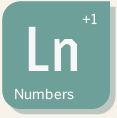 Ln: Number Of Links
Ln: Number Of Links
While you want link quality over sheer number of links, plenty of sites have found that getting many links can add up.
In particular, viral linkbaiting campaigns can be effective and something even search engine representatives have suggested.
But in your quest for links, don’t fire up automated software and begin blog spamming. That’s a bad thing, in many ways, as we’ll explore later in this guide.
Social Media & Ranking In Search Results
Using links as an Off The Page ranking factor was a great leap forward for search engines. But over time, links have lost their value for a variety of reasons. Some sites are stingy about linking out. Others block many links to help fight spam. Links get bought and sold, making them less trustworthy.
Enter social media. If links were a way for people to “vote” in favor of sites before, social media sharing is a far earlier way for that type of voting behavior to continue. Social signals are continuing to rise as an important ranking factor that search engines are using.
 Sr: Social Reputation
Sr: Social Reputation
Just as search engines don’t count all links equally, nor do they view all social accounts as being the same. That makes sense, since anyone can easily create a new account on a social network. What’s to prevent someone from making 100 different accounts in order to manufacture fake buzz?
Nothing, really, other than fake accounts like these can be easy to spot. They may have few “quality” friends in their network. Few might pass along material they share.
Ideally, you want to gain references from social accounts with good reputations. Having a social account with a good reputation of its own is great, too. So participate in the social world in a real, quality way, just as you would with your web site.
To understand more about how search engines are making use of social signals, see this in-depth report below:
 Sr: Social Reputation
Sr: Social Reputation
Similar to links, while getting quality social shares is ideal, being shared widely on social networks by many is still helpful.
Again, participation in social sharing sites is crucial. If you don’t have a Twitter account, a Facebook fan page, a LinkedIn group, you’re missing out on opportunities to be easily shared. You’re not building up a network that can help spread the news.
What about Google’s recently launched Google +1? That yet another form of social share, and one that Google says definitely is a factor in your favor for rankings.
To learn more about Google +1 along with other social sharing tips and social’s impact on search results, see the Search Engine Land articles below:
- Has Facebook Become The Master Key To Unlocking The Web?
- By The Numbers: How Facebook Says Likes & Social Plugins Help Websites
- How To Optimize For Facebook’s New ‘Like’ Functionality
- How To Put The Facebook “Like” Button On A Site
- How To Convert Website Visitors Into Facebook Fans
- How To Convert Website Visitors To Facebook Likes
- Likes Are Not Loves – How To Waste Time “Marketing” In Facebook
Bing & Facebook
- The Twitter Search Revolution: Popular & Promoted Tweets Mature The Service
- The New Twitter & Search, An Illustrated Guide
- Move Over Time Sorting: Twitter Gets “Top Tweets” Search Results
- The “Anyone Know” Search: How Twitter Is Good For More Than Brand Monitoring
- Twitter Intros Instant Follow Button
- How To Convert Visitors To Tweeters
- How To Convert Website Visitors Into Twitter Followers
- It’s Not “He Said, She Said” Over Google Rankings & Facebook Shares
- Meet +1: Google’s Answer To The Facebook Like Button
- It’s Here: Google +1 Buttons For Websites
Trust, Authority & Search Rankings
If search engines can decide to trust links or social accounts, can they learn to trust web sites? Sure, and many SEOs believe that site trust plays a big role in whether a site will succeed or fail with search engine rankings.
 Ta: Are You A Trusted Authority?
Ta: Are You A Trusted Authority?
Is your site an authority? Is it widely recognized as outstanding in its field, area, business or in some other way? That what you’re aiming for.
No one knows exactly how search engines calculate authority and, in fact, there are probably multiple “authority” signals that are tracked. The type of links your site receives (lots of quality?) or social references (from respected accounts?) and engagement metrics may all factor in. Negative review might also hurt, as covered below:
But there’s little doubt that search engines do try to assess an overall authority figure. Just look through the questions that Google told publishers to ask themselves in May 2011, if they were hit by the “Panda” update. Trust, authority, expertise all come up:
 Th: How’s Your Site’s History
Th: How’s Your Site’s History
Since search engines are constantly visiting your web site, they can get a sense of what’s “normal” or how you’ve behaved over time. Are you suddenly linking out to what the search engines euphemistically call “bad neighborhoods?” Are you publishing content about a topic you haven’t typically covered? Such things might raise alarm bells.
Then again, sites do change just like people do, and often for the better. Changes aren’t taken in isolation; other factors are also assessed to determine if something worrisome has happened.
In the end, a good overall track record may help you. An older, established site may find it can keep cruising along with search success, while a new site may have to “pay its dues,” so to speak, for weeks, months or even longer to gain its own respect.
Also see the articles, which look specifically at domain registration issues:
- Do Links From Expired Domains Count With Google?
- Google Says Domain Registrations Don’t Affect SEO, Or Do They?
Personalization & Search Engine Rankings
Years ago, everyone saw exactly the same search results. Today, no one sees exactly the same search results, not on Google, not on Bing. Everyone’s getting a personalized experience.
Of course, there’s still a lot commonality that’s shared. It’s not that everyone sees completely different listings. Instead, everyone sees many of the same “generic” listings. But there will also be some listings appearing because of where someone is, who they know or how they surf the web.
 Pc: What Country?
Pc: What Country?
One of the easiest personalization ranking factors to understand is that people are shown results relevant to the country they’re in.
Someone in the US searching for “football” will get results about American football; someone in the UK will get results about the type of football that Americans would call soccer.
If your site isn’t deemed relevant to a particular country, then you’ve got no change of showing up when country personalization happens. If you feel you should be relevant, then you’ll probably have to work on your international SEO. The articles below offer some tips on this:
- Local SEO & International SEO Have Lots In Common
- Coping With The Increasing Complexity Of International SEO
Be sure to also see our Multinational Search column.
 Pl: What City Or Locality?
Pl: What City Or Locality?
Search engines don’t stop personalizing at the country level. They’ll tailor results to match the city or metropolitan area that someone is in.
As with country personalization, the same holds true. If you want to appear when someone gets city-specific results, you need to ensure your site is relevant to that city.
The articles below provide some advice here:
- New Place Search Shows Google’s Commitment To Local
- Local SEO Primer: How To Rank Higher In Google Place Search
- 10 Unorthodox Ideas For Local Citations & Links
Also be sure to see our Locals Only column.
Beyond that, there are dedicated local search engines that people specifically use when they “overtly” want local results (rather than the search engine guessing they may want these, even if they issue a query that might not seem local in nature).
Those interested in this should check out the Local Search Ranking Factors survey that’s done on a regular basis.
 Ph: Personal History
Ph: Personal History
What has someone been searching on and choosing from their search results? What sites do they regularly visit? Have they “Liked” a site using Facebook, shared it via Twitter or perhaps Google +1′d it?
This type of personal history is used by both Google and Bing to help determine influence what will show up for someone. Unlike with country or city personalization, there’s no easy (or easier) way to try and make yourself relevant to them.
Instead, it’s largely a case of first impressions count. If you’ve been in front of them at some point through “regular” search rankings, you want to ensure you’re presented a great experience so they’ll come again, reinforcing your site as one that they should be shown more frequently. Even better, perhaps they’ll favor you with a Like or a +1.
For more on this type of personalization, see the stories below:
- Google Now Notifies Of “Search Customization” & Gives Searchers Control
- Google Now Personalizes Everyone’s Search Results
- Google’s Personalized Results: The “New Normal” That Deserves Extraordinary Attention
- Bing Results Get Localized & Personalized
 Ps: Personal Social Connections
Ps: Personal Social Connections
What do someone’s friends think about a web site? This is one of the newest ranking factors to be impacting search results. Someone’s social connections can influence what they see on Google and Bing.
Here, you have both a case of first impressions counting plus the need to ensure you’re participating in social networks. If someone can follow you, or easily share your content, that helps get your site into their circle of trust and increases the odds that others they know will find you.
For more, see our articles below:
- Bing, Now With Extra Facebook: See What Your Friends Like & People Search Results
- Bing Ups Ante In Social Search, Adds More Facebook “Likes” To Search Results
- Meet +1: Google’s Answer To The Facebook Like Button
- Google’s Search Results Get More Social; Twitter As The New Facebook “Like”
Violations & Search Engine Spam Penalties
So far, we’ve discussed the positive signals that make up the Periodic Table Of SEO Ranking Factors. But there are also some negative factors that you should avoid.
A word of reassurance. Very few people who believe they’ve spammed a search engine have actually done so. It’s hard to accidentally spam. Search engines also look at a variety of signals before deciding if someone deserves a harsh penalty.
OK, let’s talk about things not to do!
 Vt: “Thin” or “Shallow” Content
Vt: “Thin” or “Shallow” Content
It’s a brand new penalty, because Google until recently couldn’t even decide if just having so-so content really should be treated the same as overt spam techniques.
But when Google rolled out its “Panda” update in February 2011, having what it described as “thin” or “shallow” content, content that was lacking substance, became a reason for that content to take a penalty hit.
To learn more about this, see some of our articles below:
- Google Forecloses on Content Farms With “Farmer” Algorithm Update
- Your Site’s Traffic Has Plummeted Since Google’s Farmer/Panda Update. Now What?
- Lessons Learned at SMX West: Google’s Famer/Panda Update
- The Farmer/Panda Update: New Information From Google and The Latest From SMX West
- Google Rolls Out Its Panda Update Internationally And Begins Incorporating Searcher Blocking Data
- It’s Panda Update 2.1, Not Panda 3.0, Google Says
- Impacted By Google’s Panda Update? Google Asks You To Consider This…
 Vs: Keyword Stuffing
Vs: Keyword Stuffing
It’s one of the oldest spam tactics on the books. Search engines say to use words you want to be found for on your pages. OK, I’ll give them those words over and over again! How about 100 times. In a row? That work for you, Google?
Actually, no, it doesn’t. But “keyword stuffing” like this could get you penalized.
How often is too often? There’s no correct answer here, but you’d really have to go to extremes to cause this penalty to kick in. It’s most likely to happen to non-SEOs who just don’t know better and might decide to paste a word many times in a row, typically at the bottom of a web page.
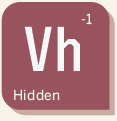 Vh: Hidden Text
Vh: Hidden Text
Once you decide to keyword stuff, you’re next thought will probably be “Why don’t I hide all this text that no human wants to see.” You might make the text white, so it blends with a page’s background. In doing so, you will have spammed a search engine.
Search engines don’t like anything hidden. They want to see everything that a user sees. That’s because when people do content just for the search engines, they’re often going to extremes.
Don’t hide text, whether it be using styles, fonts, display:none or any other means that means a typical user can’t see it.
 Vc: Cloaking
Vc: Cloaking
Let’s talk sophisticated hiding. How about rigging your site so that search engines are shown a completely different version than what humans see?
That’s called cloaking. Search engines really don’t like it. It’s one of the worst things you could do. Heck, Google’s even banned itself for cloaking. Seriously.
While most people are unlikely to accidentally spam a search engine, the opposite is true when it comes to cloaking. That’s why it’s such a heavy penalty, if you’re caught doing it. It’s seen as a deliberate attempt to go beyond acceptable SEO practices.
 Vp: Paid Links
Vp: Paid Links
Speaking of Google banning itself, it also banned Google Japan, when that division was found to be buying links. For 11 months.
That’s longer than JC Penney was penalized (3 months) in 2011, but JC Penney suffered another penalty of having its paid link purchase get turned into a giant New York Times article. As did several large online florists. And Overstock got hammered via a Wall Street Journal article.
The debate over whether Google show act so aggressively against those who buy and sell links has gone on for years. The bottom line is that to be in Google, you have to follow Google’s rules — and the rules say no buying or selling links in a way that they pass on search engine ranking credit.
If you choose to ignore Google’s rules, be prepared for little mercy, if you’re caught. Don’t believe programs that tell you they’re undetectable. They’re not, especially when so many of the cold-call ones are run by idiots.
As for Bing, officially it doesn’t ban for paid links, but it frowns upon such purchases.
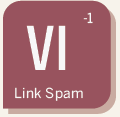 Vl: Link Spam
Vl: Link Spam
Tempted to run around and drop your links on forums and blogs all over the web, perhaps with the help of automated software?
You’re also not doing SEO, though sadly, all the people who hate the spam you leave behind get the impression that’s what SEO is about. So SEOs hate you, too.
If you do go ahead with it, it’s most likely that the links won’t give you the credit you were thinking they would. Potentially, you could face a penalty on top of that. But can you face yourself for doing the internet equivalent of peeing on everything you see, to mark your territory?
More Info & Redemption
To learn more about spam, you might check out this three part video series:
If you’re seeking redemption, here’s guidance from Google on how penalties are applied, removed and how to request reinclusion:
- Official: Google On How & When Ranking Penalties Are Removed
- How To Do A Google Reinclusion Reconsideration Request
Blocking & Search Engine Results
In 2011, blocking went main stream. Tiny Blekko kicked things off, followed soon by Google. There’s a good chance that Bing will eventually do the same.
Bp: Personal Blocking
 Blocking allows anyone who doesn’t like a search result from a site to block that site from ever appearing again in their search results.
Blocking allows anyone who doesn’t like a search result from a site to block that site from ever appearing again in their search results.
It’s as if everyone gets to be their own personal spam police. For sites that are banned, you won’t know the user has blocked you, nor will you be riincluded after a set time period expires.
You’re gone.
 Bt: Trust Blocking
Bt: Trust Blocking
Hey, who cares if a few people block you! There’s always plenty of other fish in the sea. They’ll still see you. Then again, maybe they won’t.
See, both Blekko and Google also use the aggregate blocking activity by their searchers as a negative ranking factor. Sites that are blocked by lots of individuals are effectively being nominated for overall blocking, or at least a penalty downgrade.
Bottom line? You want an engaging, quality site that’s not going to be blocked by individuals, lest you face a more widespread penalty.
To learn more about blocking, see the articles below:
- Blekko Blocks More “Spam” Domains: 1.1 Million Of Them
- New: Google Lets You Block Any Site From Search Results
- Google Rolls Out Its Panda Update Internationally And Begins Incorporating Searcher Blocking Data
